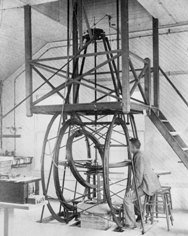The invention of a galvanometer
The first horseshoe-shaped electromagnet was made in 1825 by an American William Sturgeon (1783 - 4850). This electromagnet surprised the researchers by the speed of magnetization and demagnetization of the bar of soft iron when the current was turned on or off in the conductor with which the bar was wrapped.
Sturgeon's design was improved simultaneously and independently of each other in 1831 by Moll (1785-1838) and American Joseph Henry (1797-1878).
The first, written in Latin, Oersted's article was followed by the second, written in German, which nevertheless remained little-known. In it, Oersted showed the reciprocity of the electromagnetic phenomenon that he discovered. He hung a small battery to the wire, closed the circuit and recorded its rotation as the magnet approached it. The same thing, independently of Oersted, discovered and Amper, to whom this discovery is usually attributed.
It was even easier to demonstrate the action of the magnet on the moving element of the Davy current, bringing the pole of the magnet closer to the electric arc by Arago's advice. Sturgeon modified the experience of Davy and gave his experiment the form in which he is demonstrated today in physics lessons, when the arc continuously rotates in a magnetic field.

But the first physicist, who managed to get the rotation of a conductor with a current in a magnetic field, was Faraday. In 1821, he designed a very simple device: the end of the suspended conductor was lowered into a reservoir of mercury, into which a vertical magnet slightly protruding above the surface of the mercury came from below. When the current passed through the mercury and the conductor, the latter began to rotate around the magnet. Faraday's experience, brilliantly modified by Ampere, was then varied countless ways throughout the entire 19th century.
Here we will only mention the "wheel Barlow" described in 1823, because it is a kind of electric motor that can still serve today for educators for educational purposes. This is a metal wheel with a horizontal axis, the edge of which is immersed in a tub of mercury and is located between the poles of the horseshoe-shaped iron magnet. If the current flows from the wheel axis to its periphery and then through mercury, the wheel rotates.
Oersted's rules on the deflection of the magnetic needle and the corresponding Ampere rule indicated that the deviation increases if the same current is passed over both the magnetic arrow and below it. This phenomenon, predicted by Laplace and well studied by Ampere, was used in 1820 by Johann Schweigger (1779-1857) for the construction of a multiplier that was a rectangular frame wound several times with a wire through which the current flowed. In the middle of the frame was placed a magnetic needle.
Almost simultaneously Avogadro and Michelotti built another type of multiplier, undoubtedly much less successful than Schwegger; A description of it was published in 1823. However, in the animator Avogadro and Michelotti, there was one innovation: a magnetic needle suspended on a thread, rotating over the ruled sector, and the whole apparatus was placed under a glass cap.
At first it seemed that the multiplier was an extremely sensitive galvanometer, but soon found that it could be significantly improved. Already in 1821, Ampere constructed an "astatic apparatus", as he called it, similar to that used by Vassalli Eandy, and even earlier, in 1797, John Tremery.
The device consisted of two parallel rigidly connected magnetic arrows with poles directed in opposite directions. The entire system was suspended on the point, and it was possible to observe how it turned when passing an electric current through a parallel conductor located very close to the lower arrow. In this way, Amper proved that the magnetic needle, when it is not subject to the magnetic influence of the Earth, is perpendicular to the current.
Leopoldo Nobili (1784-1835) came up with a good idea to combine Ampère's astatic apparatus with a suspension on strings, like that of Avogadro and Michelotti; So he came to his famous astatic galvanometer, the first description of which he presented at a meeting of the Modena Academy of Sciences on May 13, 1825. To give an idea of the sensitivity of this instrument, Nobile remarks that if you connect the ends of the galvanometer wire with iron wire, Joints with your fingers, so that the arrow will deviate by 90 °.
Galvanometer Nobili for several decades remained the most sensitive measuring device in physical laboratories. In 1828, Oersted decided to improve it by using an auxiliary horseshoe magnet. This attempt was unsuccessful, but it should nevertheless be mentioned as the first device with an auxiliary field.
These measuring instruments were significantly improved only with the appearance in 1837 of the tangent clutch of Claude Pouyet (1790-1868) and the sine-busison, which had already been used the year before by the same Pouilly. Perhaps Pouye himself did not know exactly the theory of the action of his instrument, which was given in 1840 by Wilhelm Weber (1804-1891).

In 1837, AS Becquerel invented the "electromagnetic balance", which became widespread only in the second half of the century. Then other types of tangent-beads appeared: Helmholtz (1849), Gogen (1853), Kohlrausch (1882). In the meantime, Poggendorf, from 1826, introduced a method of mirror reading, developed later by Gauss (1832) and applied in a mirror galvanometer by Weber in 1846.
A galvanometer was invented with great enthusiasm, invented in 1886 by D'Arsonval (1851-1940), in which, as is known, the measured current passes through a light mobile coil placed in a magnetic field.
Mario Lezzi "History of Physics"


Comments
When commenting on, remember that the content and tone of your message can hurt the feelings of real people, show respect and tolerance to your interlocutors even if you do not share their opinion, your behavior in the conditions of freedom of expression and anonymity provided by the Internet, changes Not only virtual, but also the real world. All comments are hidden from the index, spam is controlled.